Designated Lines
The Department for Transport announced a pilot project in 2005 under their Community Rail Development Strategy, with the intention of having seven differing lines (Abbey Line, Esk Valley Line, Looe Valley Line, Penistone Line, Poacher Line, St Ives Bay Line, and Tamar Valley Line) test out different types of community rail schemes. The aims of these schemes are to:
- establish the contribution of Community Rail Development in achieving locally set objectives such as reducing road congestion and increasing accessibility
- establish the costs for the line and services
- establish the effectiveness of different methods for reducing the net financial loss of Community Rail lines by increasing revenue and reducing costs where practicable
Designation does not physically separate a line from the rest of the network or remove it from either Network Rail or franchise operation. It is not generally intended to be used as a mechanism to reopen lines or create "microfranchises", although these options may be investigated on some routes.
In addition each line has a remit agreed in a route prospectus which gives more detailed aims and objectives for each scheme, such as infrastructure improvements, new ticketing arrangements, or cooperation with other local transport operators.
The DfT has identified about fifty routes in England and Wales that would benefit from designation, covering 10% of Network Rail and some 390 stations. Some routes will only be designated as community rail services (rather than community rail lines) as the infrastructure may be used by other operators in a way that precludes designation. Not all of the CRPs mentioned above have been designated. Those that have so far are:

The West Coast Main Line (WCML) is one of the most important railway corridors in the United Kingdom, connecting the major cities of London and Glasgow with branches to Birmingham, Liverpool, Manchester and Edinburgh. It is one of the busiest mixed-traffic railway routes in Europe, carrying a mixture of intercity rail, regional rail, commuter rail and rail freight traffic. The core route of the WCML runs from London to Glasgow for 399 miles (642 km) and was opened from 1837 to 1869. With additional lines deviating to Northampton, Birmingham, Manchester, Liverpool and Edinburgh, this totals a route mileage of 700 miles (1,127 km). The Glasgow–Edinburgh via Carstairs line connects the WCML to Edinburgh. However, the main London–Edinburgh route is the East Coast Main Line. Several sections of the WCML form part of the suburban railway systems in London, Coventry, Birmingham, Liverpool, Manchester and Glasgow, with many more smaller commuter stations, as well as providing links to more rural towns.
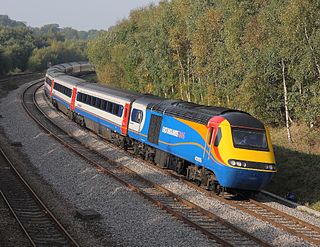
The Midland Main Line is a major railway line in England from London to Sheffield in Yorkshire via the East Midlands. It comprises the lines from London's St Pancras station via Leicester, Derby/Nottingham and Chesterfield.

Crewe railway station is a railway station in Crewe, Cheshire, England. It opened in 1837 and is one of the most historically significant railway stations in the world.

The Calder Valley line is a railway route in Northern England between the cities of Leeds and Manchester as well as the seaside resort of Blackpool. It is the slower of the two main rail routes between Leeds and Manchester, and the northernmost of the three main trans-Pennine routes.

The North Wales Coast Line, also known as the North Wales Main Line, is a major railway line in the north of Wales and Cheshire, England, running from Crewe on the West Coast Main Line to Holyhead on the Isle of Anglesey. The line has 19 stations, with all except two, Chester and Crewe, being in Wales.

The English county of Shropshire has a fairly large railway network, with 19 National Rail stations on various national lines; there are also a small number of heritage and freight lines, including the famous heritage Severn Valley Railway running along its eastern border with Worcestershire.
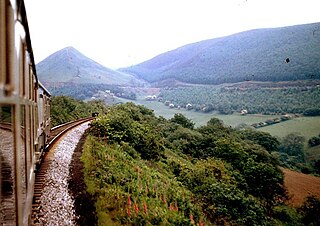
The Heart of Wales line is a railway line running from Craven Arms in Shropshire to Llanelli in southwest Wales. It serves a number of rural centres, including the nineteenth-century spa towns Llandrindod Wells, Llangammarch Wells and Llanwrtyd Wells. At Builth Road, two miles (3.3 km) from the town of Builth Wells, the line crosses the former route of the earlier Mid Wales Railway, which closed in the 1960s.

The Woodhead line was a railway line linking Sheffield, Penistone and Manchester in the north of England. A key feature of the route is the passage under the high moorlands of the northern Peak District through the Woodhead Tunnels. The line was electrified in 1953 and closed between Hadfield and Penistone in 1981.
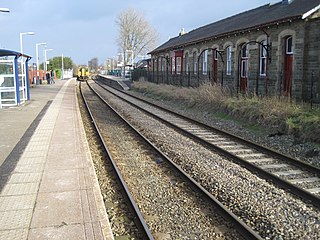
The Ribble Valley line is a railway line that runs from Manchester Victoria through Blackburn to Hellifield in Lancashire. Regular passenger services normally run as far as Clitheroe, but occasional passenger services run the whole line through north Lancashire towards the Yorkshire village of Hellifield, where it joins the Settle–Carlisle line. The line passes over the distinctive 48-span Whalley Viaduct.

The Derwent Valley line is a railway line from Derby to Matlock in Derbyshire.

Barnsley Interchange is a combined rail and bus station in the centre of Barnsley, South Yorkshire. It was first opened in 1850 as Barnsley Exchange railway station and is 16 miles (26 km) north of Sheffield. It is on the Hallam and Penistone Lines, both operated by Northern Trains. On 20 May 2007, the new bus station and refurbished railway station were officially opened by Travel South Yorkshire, with the combined facility renamed to Barnsley Interchange.
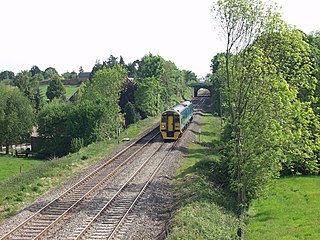
The Shrewsbury–Chester line is a railway line between Chester and Shrewsbury in England, with the line passing through Wrexham County Borough in Wales. Passenger train services are operated by Transport for Wales Rail between the northern terminal of Chester and Shrewsbury in the south as part of the Wales & Borders franchise. Some additional services, starting part way along the line to London Euston via Chester are operated by Avanti West Coast. The line was built in 1846 by the Shrewsbury and Chester Railway, with the engineer for the line being Henry Robertson, a partner in locomotive builders Beyer Peacock, while the contractor was Thomas Brassey in partnership with William Mackenzie and Robert Stephenson. The line is part of Transport for Wales' North Wales Metro improvement programme.

Shotton railway station serves the towns of Shotton and Connah's Quay, Flintshire, Wales. It is situated where the Borderlands Line crosses the North Wales Coast Line. All passenger services are operated by Transport for Wales, which manages the station.
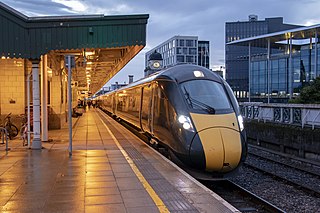
Transport in Wales is heavily influenced by the country's geography. Wales is predominantly hilly or mountainous, and the main settlements lie on the coasts of north and south Wales, while mid Wales and west Wales are lightly populated. The main transport corridors are east–west routes, many continuing eastwards into England.
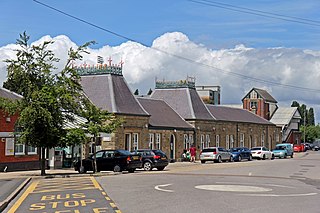
Wrexham General is the main railway station serving the city of Wrexham, north-east Wales, and one of the two serving the city, alongside Wrexham Central. It is currently operated by Transport for Wales, but services are also provided by Avanti West Coast who operate a service to London Euston. Until January 2011 Wrexham & Shropshire also operated from here to London Marylebone.

Chirk railway station serves the town of Chirk, Wrexham County Borough, Wales. The station is on the Shrewsbury to Chester Line 21 miles (34 km) north of Shrewsbury, which is part of the former Great Western Railway mainline route from London Paddington to Birkenhead Woodside. The original 19th-century Chirk / Y Waun station building was demolished in 1987, without consultation, by the local council.

Urban or suburban rail plays a key role in public transport in many of the United Kingdom's major cities. Urban rail refers to the train service between city centres and suburbs or nearby towns that acts as a main mode of transport for travellers on a daily basis.
Network Rail's (NR) strategic route 23 encompassed mainly the English rural railway lines of Lancashire and Cumbria. It excluded the part of the West Coast Main Line (WCML) that bisects the counties. It included the following lines:
The Crewe and Shrewsbury Railway was a railway company which was previously owned by the London and North Western Railway (LNWR), built to connect Crewe with the Shrewsbury and Hereford Railway which was jointly owned with GWR.
Tavistock railway station is a proposed new station to serve Tavistock in Devon, England, in order to reinstate a rail connection between the town and Plymouth, about 13 miles (21 km) to the south.
















